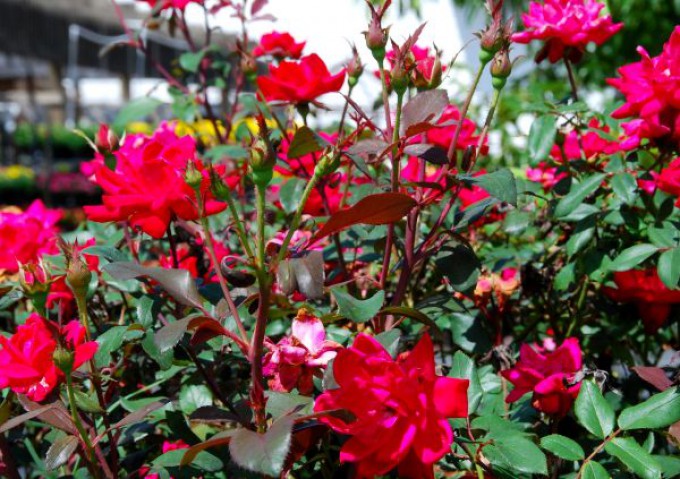You have given them the perfect soil, sited your plant in the “right” amount of sun/shade, watered appropriately … and three months later your beautiful green plant is as brown as toast. What happened?! The funny thing is that plants often have the same symptoms whether you over watered or under watered, or if they were sick or just in too much sun. There are many ways to diagnose the problem, but sometimes even the best gardeners do not always know.
The first thing I always check is the soil. Is it too wet or too dry? Are other plants around the new ones struggling too? Test your soil pH (our Piedmont Triad soils tend to be very acidic.) Even after your plant has died it is worth digging it up to investigate what was going on underground so you do not repeat the problem. Also try looking up the specific plant online to see if it is often attacked by specific bugs or disease that is treatable or preventable.
Indeed, I planted 3 Rhododendron last spring in my Summerfield garden, that quickly turned to toast.

Nice Rhodies, Huh?
I had thoroughly prepared the soil (dug out all of the tree roots, checked the pH, provided loads of organic matter) split the root ball, planted them in bright shade, mulched and watered them. My friend Sager dug them up for me. Here is what we found…

Tree Roots!
TREE ROOTS had completely overtaken the entire bed! My little rhodies didn’t have a chance against these thugs that choked them out and sucked up every bit of moisture! My hellebores & caladiums survived, but rhodies (& azaleas) do not forgive you when they dry out. Solution: since I do not want to cut down my tree, my plant choices will include more drought tolerant plants such as hellebores, sedum, catmint and sedge on the sunniest side of the bed.
Rose Rosette Virus
In many situations a plant’s decline is so gradual we do not recognize there is a problem until it is too late. A major plague of roses is Rose Rosette Virus, and Knock-Out Roses are not immune to it. In fact this photo was only one of a mass planting of Knock-outs in Greensboro, NC that were horribly disfigured from the virus.

Compare diseased roses on right with still healthy ones on left.

Rose Rosette virus. Note the witch’s brooms of new growth.

Rose rosette virus close up.

Healthy Knock-out Roses (a.k.a. “Kick-A#*” roses)
Microscopic Eriophyid mites (less than 1/200 inch long) move easily on wind currents to spread this virus. Once the first plant gets the virus others nearby are very likely to follow. Infested plants could be unknowingly purchased and introduced to your landscape. Once a plant is infected the virus moves throughout the entire plant, including the roots and shoots. When plants are as diseased as these they are not curable, so it is best to remove any diseased plants from the landscape.
Symptoms include witch’s brooms, gnarly misshapen stems & leaves, abnormal red color on new growth, and deformed buds and flowers. If you prune this kind of growth out of your rose bush ASAP before it has more than a couple of days on your plant you may be able to stop the spread. Sterilize pruners before using again on other roses. Early detection of the disease is crucial to saving your rose and keeping other nearby roses healthy.
Got trouble in your garden? Do not despair. If you are not killing plants it is because you are not gardening! In the famous words of Tony Avent, “You don’t really know a plant until you have killed it at least 3 times.” (Translation: “Observe & learn what your plants are telling you.”) I also recommend Tom Rainer’s Blogspot (My favorite!) for a bit of insight and inspiration: Landscape of Meaning Blogspot
Planting Reminder
NOW is the best time to plant almost anything in your garden, especially trees, shrubs, berries, pansies and snapdragons. October is also the perfect month to plant garlic, and spring bulbs such as alliums, crocus, daffodils & tulips.
You can cut back most perennials now too. Tired foliage should be cut to the ground and cleared away. Finish dividing and moving them by mid-October. Do not cut back tender perennials such as Angel’s trumpet, lantana, and verbena until spring. Be sure to mark perennials with a plant tag because you may not see them again until spring. Hold off on major pruning of woody plants until February. If you love muscadines, you can find them at the farmers market now.
Events
The Guilford Horticultural Society has just kicked off a new season of excellent speakers. Here is the invitation letter with the meeting schedule that you may view or print: 2014-2015 GHS Membership Letter More information is online at: http://www.guilfordhorticulturalsociety.org/ The next meeting is Monday, October 20th at 7pm at the Greensboro Science Center. I hope to see you there!
Happy Gardening!
Ellen









Another amazing post.
Thanks for all the help, Ellen.